功能翻译理论
功能翻译理论
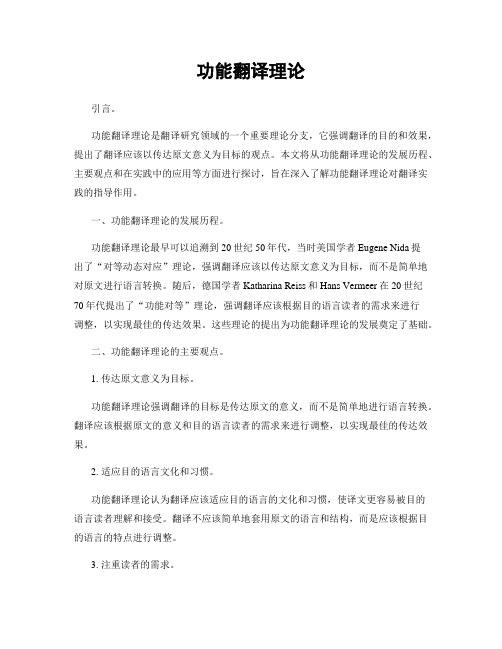
功能翻译理论引言。
功能翻译理论是翻译研究领域的一个重要理论分支,它强调翻译的目的和效果,提出了翻译应该以传达原文意义为目标的观点。
本文将从功能翻译理论的发展历程、主要观点和在实践中的应用等方面进行探讨,旨在深入了解功能翻译理论对翻译实践的指导作用。
一、功能翻译理论的发展历程。
功能翻译理论最早可以追溯到20世纪50年代,当时美国学者Eugene Nida提出了“对等动态对应”理论,强调翻译应该以传达原文意义为目标,而不是简单地对原文进行语言转换。
随后,德国学者Katharina Reiss和Hans Vermeer在20世纪70年代提出了“功能对等”理论,强调翻译应该根据目的语言读者的需求来进行调整,以实现最佳的传达效果。
这些理论的提出为功能翻译理论的发展奠定了基础。
二、功能翻译理论的主要观点。
1. 传达原文意义为目标。
功能翻译理论强调翻译的目标是传达原文的意义,而不是简单地进行语言转换。
翻译应该根据原文的意义和目的语言读者的需求来进行调整,以实现最佳的传达效果。
2. 适应目的语言文化和习惯。
功能翻译理论认为翻译应该适应目的语言的文化和习惯,使译文更容易被目的语言读者理解和接受。
翻译不应该简单地套用原文的语言和结构,而是应该根据目的语言的特点进行调整。
3. 注重读者的需求。
功能翻译理论认为翻译应该注重目的语言读者的需求,使译文更符合他们的阅读习惯和阅读理解能力。
翻译不应该只关注原文的表达方式,而是应该根据读者的需求来进行调整。
三、功能翻译理论在实践中的应用。
功能翻译理论在实践中具有重要的指导作用,它可以帮助翻译人员更好地理解翻译的目的和效果,从而提高翻译质量和效果。
具体来说,功能翻译理论在以下几个方面得到了广泛的应用:1. 广告翻译。
在广告翻译中,功能翻译理论可以帮助翻译人员更好地理解目的语言读者的需求,使译文更符合他们的阅读习惯和阅读理解能力。
翻译人员可以根据目的语言的文化和习惯来进行调整,使广告更容易被目的语言读者接受和理解。
德国的功能派翻译理论
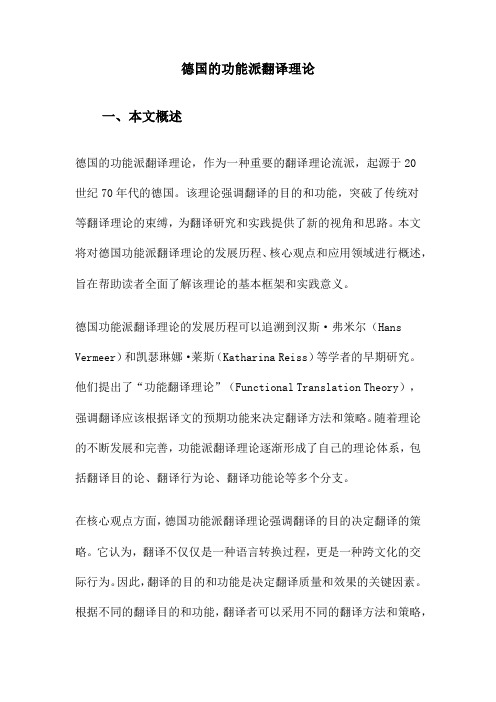
德国的功能派翻译理论一、本文概述德国的功能派翻译理论,作为一种重要的翻译理论流派,起源于20世纪70年代的德国。
该理论强调翻译的目的和功能,突破了传统对等翻译理论的束缚,为翻译研究和实践提供了新的视角和思路。
本文将对德国功能派翻译理论的发展历程、核心观点和应用领域进行概述,旨在帮助读者全面了解该理论的基本框架和实践意义。
德国功能派翻译理论的发展历程可以追溯到汉斯·弗米尔(Hans Vermeer)和凯瑟琳娜·莱斯(Katharina Reiss)等学者的早期研究。
他们提出了“功能翻译理论”(Functional Translation Theory),强调翻译应该根据译文的预期功能来决定翻译方法和策略。
随着理论的不断发展和完善,功能派翻译理论逐渐形成了自己的理论体系,包括翻译目的论、翻译行为论、翻译功能论等多个分支。
在核心观点方面,德国功能派翻译理论强调翻译的目的决定翻译的策略。
它认为,翻译不仅仅是一种语言转换过程,更是一种跨文化的交际行为。
因此,翻译的目的和功能是决定翻译质量和效果的关键因素。
根据不同的翻译目的和功能,翻译者可以采用不同的翻译方法和策略,以实现最佳的交际效果。
在应用领域方面,德国功能派翻译理论广泛应用于各种翻译实践,包括文学翻译、商务翻译、法律翻译、医学翻译等。
它不仅为翻译实践提供了理论指导,还为翻译质量的提高提供了有效保障。
该理论也促进了翻译学科的多元化发展,为翻译研究注入了新的活力。
德国功能派翻译理论作为一种重要的翻译理论流派,为翻译研究和实践提供了新的视角和思路。
本文将对这一理论进行全面概述,帮助读者深入了解其发展历程、核心观点和应用领域。
二、德国功能派翻译理论概述德国功能派翻译理论,也被称为“功能主义翻译理论”或“目的论翻译理论”,起源于20世纪70年代的德国。
这一理论的核心观点是,翻译并非简单的语言转换过程,而是一种具有特定目的和功能的社会行为。
功能派翻译理论强调翻译过程中译者的主观能动性,认为译者应根据翻译的目的和受众的需求,选择适当的翻译策略和方法。
功能翻译理论

功能翻译理论(functional translation theory)简述功能翻译理论(functional translation theory)诞生在20世纪70年代的德国,形成这一理论有三个杰出贡献者:Katharine Reiss, Hans J. Vermeer and Christiane Nord。
根据杂志上发表的论文、学术会议上宣读的论文、学术报告和出版的专著,功能翻译理论(functional translation theory)的要点简述如下:1、分析概念段(conceptual paragraph,具有明确主题意义一个或多个自然段)和句子的修辞功能,使修辞功能的形式重现,从形式的等同中求得功能的等值,意义的等值,这种翻译叫做功能翻译。
翻译应该是在修辞功能等值的前提下,遵守“信、达、X”规范;文体不同,翻译的目的不一样,X不一样。
(张梅岗,《中国科技翻译》,1994,(3);刘重德,《三湘译论》,湖南出版社,1995;周笃宝,《中国翻译》,2000,(2))2、功能翻译理论(functional translation theory)强调修辞形式等同和功能等值的一致性,修辞是手段,是形式;功能是修辞产生的结果或达到的目的,是内容的总和。
修辞包括概念段内和句内的修辞,即语言语境的修辞,也包括情景语境、文化语境、语用语境的修辞。
(《科技英语修辞》,1998)换句话说,在概念段和句子中,语义、语法和语用三者合为一体表达修辞功能。
3、功能是靠结构(structures)来体现的,任何一种语言都是由四种符号元素(词、词标识、词序和语调)构成。
语言结构(constructions)的认知图式与其他认知领域的认知图式类似,由简单到复杂,由具体到抽象,构成语言因果网络。
概念段贯穿了一条主题链,或称因果键。
这条因果键是命题或语言事件构成的,也是它们的概念化的参考点。
(《中国翻译》,1998,(5)此文已被美国Colby Information Center of Science & Culture收录,网上转载。
德国功能翻译理论

e.g. 奈达早在1964年区分“形式对等”和“功能对等”。 20世纪70年代以来语用学受到更多的关注, 翻译代为由词、短语转移到了语篇, 但基本的语言学框架没变。 在功能主义翻译学派成为主流之前, 以对等论为基础的语言学派在德国翻译界占主导地位。其代表人物是Wilss 和Koller等。
科勒指出: 如果译文能够满足有关结构条件的某些要求,那么原文和译文便存在着对等。这些相关的条件跟内容、风格以及功能有关。因而对等的要求便体现为: 原文的质量必须得以保留。也就是说原文的风格、内容及功能必须得以保留,或者至少译文应该尽可能地保留这些特征。 对等论者一般都侧重于原文,认为原文的特征必须在译文中得以保留。
Dacron 的确凉 TOFEL 托福 第六届中国厦门对台商品交易会暨海峡两岸机械电子商品展销会 The sixth China Xiamen Commodity Fair & Machinery and Electronics Exhibition
在家靠自己, 出国靠国旅 At home you’re your own boss. In china your Aladdin’s Lamp is at CITS
e.g. Cette semaine on tuer le cochon. this week we (will) kill the pig. 这个星期我们杀猪。 为实现译文功能。只能改写: Special offer—Fresh and abundant
删减与改写
删减和改写在文学类语篇翻译有时是一种必要。(见P39) 在应用语篇的翻译中, 则是常常必须借助的手段。
在目的论的框架下, 决定翻译目的的最重要因素之一便是受众——依着心目中的接收者, 他们有自己的文化背景知识, 对译文的期待及交际需求。每一种翻译都指向一定的受众, 因此翻译是在 “目标语情景中为某种目的及目的受众而生产的文本”(Vermeer) 费米尔的理论中较少提及原文, 可见目的论中原文明显低于对等论中原文的地位。费米尔认为原文只是为目的语受众提供部分或全部信息的源泉。
功能翻译理论

功能翻译理论功能对等翻译理论是,奈达理论的核心概念是“功能对等”。
所谓“功能对等”,就是说翻译时不求文字表面的死板对应,而要在两种语言间达成功能上对等。
功能翻译论翻译出来的译本是有一定功能的;翻译目的论根据翻译目的来确定译文。
译文的翻译策略、语言风格等,需要根据目的来确定。
相关内容:1、第一,努力创造出既符合原文语义又体现原文文化特色的译作。
然而两种语言代表着两种完全不同的文化,文化可能有类似的因素,但不可能完全相同。
因此,完全展现原文文化内涵的完美的翻译作品是不可能存在的,译者只能最大限度地再现源语文化。
2、第二,如果意义和文化不能同时兼顾,译者只有舍弃形式对等,通过在译文中改变原文的形式达到再现原文语义和文化的目的。
3、第三,如果形式的改变仍然不足以表达原文的语义和文化,可以采用“重创”这一翻译技巧来解决文化差异,使源语和目的语达到意义上的对等。
功能翻译理论是何时产生的?功能翻译理论是以目的论(skopos theory)为核心,强调问题和翻译功能的一种流派。
它的出现反映了翻译的全面转向:从原来站主导地位的语言学流派的注重形式的翻译观转向更加注重功能和社会文化因素的翻译观。
这种转向得益于交际理论、行为理论、话语语言学、语篇学说以及文学研究中趋向于接受理论的一系列研究活动。
功能翻译理论的形成大体经历了两个阶段。
第一个阶段是以卡瑟琳娜·莱斯(Katharina Reiss) 在1971年出版的《翻译批评的可能性与限制》一书为标志。
第二个阶段是赖斯的学生汉斯·弗米尔(Hans Vermeer)创立的功能翻译理论的核心理论。
扩展资料产生背景20世纪六七十年代,德国译学界深受结构主义语言学的影响,形成了以扭伯特卡德为代表的莱比锡学派和以威尔斯为代表的萨尔派。
前者立足于转换生成语法,在翻译中严格区分不变的认知因素和可变的认知因素;后者是奈达学说的追随者,主张建立翻译科学。
“对等”成为了翻译研究的中心,各种借鉴语言学理论的翻译对等论应运而生,但大都不过是对等形式的重新组合。
基于功能翻译理论的英语翻译研究

基于功能翻译理论的英语翻译研究引言一、功能翻译理论的基本概念功能翻译理论(Functional Translation Theory)是一种现代化的翻译理论,它强调翻译的目的和功能,强调翻译的基本任务是完成信息的传递和交流,让源语言向目标语言更好地传达信息。
功能翻译理论源于 20 世纪 60 年代的语用翻译学,最初是由法国学者鲁陶斯(Eugene Nida)和他的学生最早提出,并在世界范围内得到广泛应用。
与传统的“对等”或“文本中心”的翻译理论不同,功能翻译理论着重考虑不同语言和文化之间的交流目的与需求,强调在翻译过程中应该注重传达信息的精确性和清晰度,并在目的语语境中达到适当的功能。
因此,根据不同的翻译任务,它分为三种类型:信息翻译、美学翻译和文化翻译。
其中,信息翻译是指用较为严密、精准的语言将源语言中的信息传递给目标语言接受者;美学翻译是指一种以保持源语言文本美感为目的的翻译方式,着重传递文本的美感和风格;文化翻译则是指涉及某些文化特征和习惯的问题,强调有意识地将源语词汇和表达方式转化为目标语文化的表达方式。
二、英语翻译的实践应用基于功能翻译理论的英语翻译实践应用非常广泛,我们可以从以下几个方面来分析。
1. 提高英语翻译准确性英语翻译实践中最关键的问题是准确传递源语信息。
对于普通信息的翻译,翻译者应当用精确的语言转化源语信息。
对于文学、法律或科技文献中的专业术语、词汇以及表达方式,则应当在熟练掌握相关领域的基础上,精心地选择不同的翻译方式。
翻译者不仅要熟悉英语语言运用规则,而且必须具备在某种语境下进行精确语言转换的能力。
在英语翻译的过程中,明确进行信息交流的目的和需求,注重传达信息的准确性和清晰度,才能更好地实现翻译的基本任务。
2. 注意英语翻译的文化特色另一个重要方面是注意英语翻译的文化特色。
不同文化之间的差异会影响到翻译的准确性和流畅性。
在翻译过程中,翻译者应当注重源语文本的文化背景和传统,然后进行转译。
论功能翻译理论

论功能翻译理论【摘要】功能翻译理论是一种翻译理论,强调翻译的目的和效果。
本文从引言部分介绍了功能翻译理论的概念和历史背景,接着探讨了功能翻译的定义、特点、原则以及在实践中的应用。
同时还讨论了功能翻译与语言学习的关系,以及功能翻译的局限性。
在文章总结了功能翻译理论的意义,并展望了其发展前景。
功能翻译理论为翻译研究提供了新的视角和方法,有助于提高翻译质量和效率,促进不同语言和文化之间的交流与理解。
【关键词】功能翻译理论、翻译理论、历史背景、定义、特点、原则、实践应用、语言学习、局限性、意义、发展前景、总结。
1. 引言1.1 介绍【论功能翻译理论】功能翻译理论是一种翻译理论,旨在强调翻译是为了实现特定功能而进行的。
与传统的翻译理论不同,功能翻译理论不仅关注词语和语法结构的对应,更侧重于传达原文所要表达的意义和目的。
功能翻译理论认为翻译应该是“再创造”的过程,译者应该根据所翻译的文本和受众的需求,灵活运用各种翻译策略,以达到最佳的传达效果。
功能翻译理论的出现与语言学习和跨文化交流的需求息息相关。
在全球化的今天,人们需要更多地进行跨文化交流和理解,而翻译作为信息传递的重要手段,扮演着至关重要的角色。
功能翻译理论的提出,正是为了更好地适应这种需求,使翻译更加灵活、准确地传达信息。
功能翻译理论是一种注重实践和功能性的翻译理论,通过对翻译的目的和意义进行深入思考,帮助翻译者更好地理解并实践翻译活动。
在接下来的我们将更深入地探讨功能翻译的定义、原则、应用以及局限性,以便更全面地了解这一翻译理论的特点和意义。
1.2 翻译理论的历史背景翻译理论的历史背景可以追溯到古代文明时期,人类在不同文化和语言之间进行交流和沟通的需求促使了翻译的出现。
在古代,翻译主要是为了传播宗教、文学和政治等领域的知识和信息。
随着文明的不断发展和交流的日益频繁,翻译的地位和作用逐渐得到认可和重视。
在近现代,翻译理论开始逐渐形成并得到系统的阐述。
功能翻译理论

功能翻译理论《功能翻译理论》是一种新兴的翻译理论,它与传统的翻译理论有很大的不同,因此产生了很多可讨论的话题。
《功能翻译理论》最早是芬兰语言学家乔斯卡梅里埃尔在1960年发表的著作《翻译研究:从技术性翻译到概念翻译》中提出的。
梅里埃尔认为,翻译并不是一种字面上的表达,而是将原作的意思准确地传达到目标语言中的一种艺术形式。
因此,解决翻译问题的重点不在于简单的字面翻译,而是要确保受译文的读者能够准确地理解原作的定义和意义。
《功能翻译理论》重新定义了翻译的定义,从机械性翻译升级到有意义的翻译,这也被称为“功能翻译”。
《功能翻译理论》主要分为三个层次:语用学派、功能学派和功能定位主义。
语用学派重视翻译中的语用问题,认为翻译应该考虑读者的理解能力,并以此来保证翻译的目的性。
功能学派强调的是翻译的功能,认为翻译的主要功能是传播原文的意义,并试图准确地表达原文的内容。
功能定位主义则把重点放在文本的准确表达上,认为翻译应当尽量准确地传达原文的内容。
《功能翻译理论》强调一个重要的概念即读者对译文的理解。
它认为,翻译应该根据读者的文化背景、智力水平和语言能力等因素来确定翻译风格,在传达原文的意思的同时又能给读者留下良好的体验。
因此,有意义的翻译需要在表达原文的同时考虑到读者的理解能力,表达应简单明了,而且能让读者得到有价值的内容。
《功能翻译理论》也提出了一个新的概念语种模式。
它认为,一种语言的特征为一种特殊的文化模式,这一模式可以用来揭示原文的背景信息,并从中发现原文的更深层的含义,从而更好地传达原文的情意。
《功能翻译理论》的出现改变了翻译的范式,它让翻译不再局限于技术性翻译,而是向着有意义的翻译发展,它强调读者的理解能力,强化了翻译的定位思维,从而保证翻译的准确性和读者的体验感。
此外,它也为翻译的研究提供了新的思路,激发了更多的翻译理论研究。
综上所述,《功能翻译理论》是一个视角不同、范式不同的翻译理论,它改变了翻译与传统翻译,保证翻译的准确性和读者的体验感,也为翻译的研究提供了新的思路。
基于功能翻译理论的英语翻译技巧

基于功能翻译理论的英语翻译技巧功能翻译理论(Functional Translation Theory)是一种翻译理论,主张翻译应该注重功能和目的,而不仅仅是准确传达原文的语义。
功能翻译理论认为,翻译不仅仅是将原文的词语和句子转换成另一种语言,更重要的是要传达原文所要表达的意义和意图。
在进行翻译时,翻译者应该根据目标受众和目的来调整翻译策略,以实现最佳的功能翻译效果。
1. 理解原文意图:在进行翻译之前,首先要对原文的意图和目的进行深入理解。
这样可以帮助翻译者更好地把握原文的语义和情感,从而更好地将其传达到目标语言中。
2. 适应目标受众:翻译的目的是为了让目标受众理解和接受翻译文本。
在进行翻译时,翻译者应该考虑目标受众的语言背景、文化差异和专业知识,以便选择合适的词语、句式和语言风格,以符合目标受众的习惯和理解能力。
3. 重视语境:语境是翻译的重要因素之一。
翻译是一种语言活动,需要将原文的语义和情感的表达转换到目标语言中。
翻译者应该注意原文中的上下文信息、词义和语法的使用,以便在翻译中进行恰当的选择和调整。
4. 灵活运用翻译策略:在进行翻译时,翻译者应根据不同的情况灵活运用不同的翻译策略。
当原文中存在语言障碍或文化难题时,可以考虑使用意译、借译或添加解释的方法来保持信息传达的连贯性和准确性。
5. 注重译文的流畅性:翻译不仅仅是字面的转换,更重要的是要保证译文的流畅性和自然度。
在进行翻译时,翻译者应注意句子的结构、语法和语言风格,以确保译文读起来通顺、自然,并且符合目标语言的习惯和习语表达。
6. 不拘泥于结构和语法:语言是一个活动的系统,不同的语言有不同的语法结构和表达方式。
在进行翻译时,翻译者应该具备灵活运用语法规则和结构的能力,以便在不拘泥于原文结构和语法的保持译文的准确性和流畅性。
基于功能翻译理论的英语翻译技巧不仅注重准确传达原文的意义,更强调翻译的功能和目的。
通过深入理解原文意图,适应目标受众,注重语境,灵活运用翻译策略,注重译文的流畅性和自然度,以及不拘泥于结构和语法,翻译者可以实现更好的功能翻译效果。
功能翻译理论阐释

功能翻译理论阐释
功能翻译理论指的是一种语言研究的视角,它认为一段语言的意义取决于它在特定文化中的功能,以及它在这种文化中扮演的角色。
这种理论的基本假设是,语言的意义取决于它在社会中的用途,也就是它的功能,而不取决于它的内容。
即语言是用来完成特定社会任务的工具,其中包括政治、宗教、经济和教育等任务。
因此,功能翻译理论主张以保护母语文化而不是表达原文中的语义为主,从而尊重本土文化。
这可以通过采取一种精心审慎的方法来实现,即在源文的内容和技术层面上照顾到目标语言的文化元素,这样最大限度地减少文化差异带来的困扰。
例如,采用本土表达、表情符号和引用等技术手段进行功能翻译。
浅析功能翻译理论
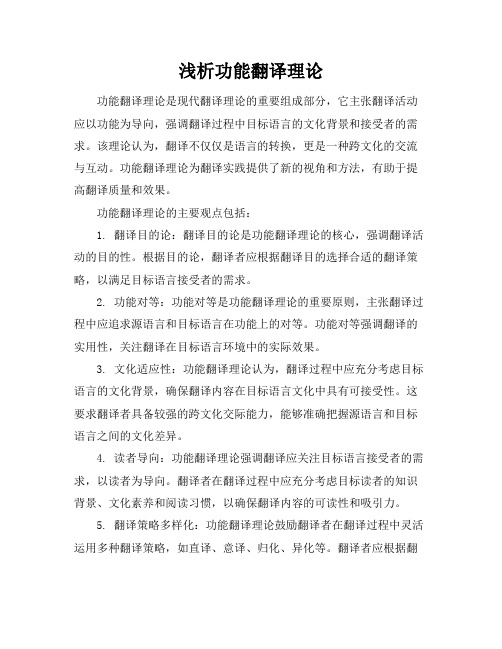
浅析功能翻译理论功能翻译理论是现代翻译理论的重要组成部分,它主张翻译活动应以功能为导向,强调翻译过程中目标语言的文化背景和接受者的需求。
该理论认为,翻译不仅仅是语言的转换,更是一种跨文化的交流与互动。
功能翻译理论为翻译实践提供了新的视角和方法,有助于提高翻译质量和效果。
功能翻译理论的主要观点包括:1. 翻译目的论:翻译目的论是功能翻译理论的核心,强调翻译活动的目的性。
根据目的论,翻译者应根据翻译目的选择合适的翻译策略,以满足目标语言接受者的需求。
2. 功能对等:功能对等是功能翻译理论的重要原则,主张翻译过程中应追求源语言和目标语言在功能上的对等。
功能对等强调翻译的实用性,关注翻译在目标语言环境中的实际效果。
3. 文化适应性:功能翻译理论认为,翻译过程中应充分考虑目标语言的文化背景,确保翻译内容在目标语言文化中具有可接受性。
这要求翻译者具备较强的跨文化交际能力,能够准确把握源语言和目标语言之间的文化差异。
4. 读者导向:功能翻译理论强调翻译应关注目标语言接受者的需求,以读者为导向。
翻译者在翻译过程中应充分考虑目标读者的知识背景、文化素养和阅读习惯,以确保翻译内容的可读性和吸引力。
5. 翻译策略多样化:功能翻译理论鼓励翻译者在翻译过程中灵活运用多种翻译策略,如直译、意译、归化、异化等。
翻译者应根据翻译目的、源语言和目标语言的特点以及目标读者的需求,选择合适的翻译策略。
功能翻译理论在翻译实践中具有重要的指导意义。
它有助于翻译者提高翻译质量,使翻译内容更符合目标语言接受者的需求。
同时,功能翻译理论也为翻译教学和研究提供了新的思路和方法,有助于培养具有跨文化交际能力的翻译人才。
功能翻译理论的实践应用功能翻译理论不仅为翻译研究提供了新的理论框架,而且在翻译实践中也展现了其独特的价值。
在全球化背景下,跨文化交流日益频繁,翻译作为桥梁的作用愈发显著。
功能翻译理论在实际应用中,帮助翻译者更好地理解和实现翻译的目的,从而提高翻译的效率和效果。
功能翻译理论
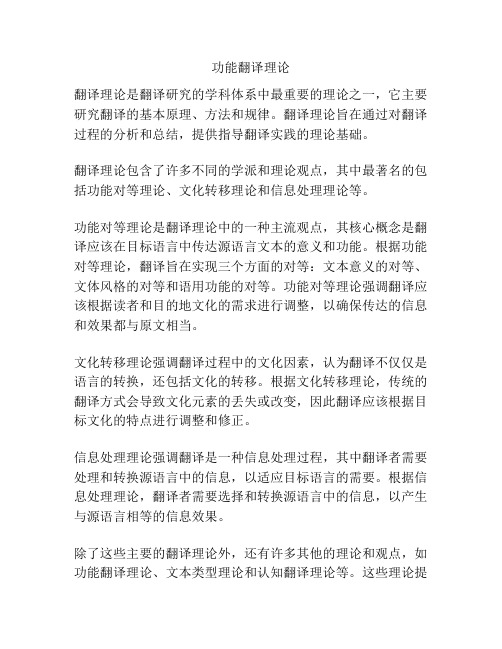
功能翻译理论
翻译理论是翻译研究的学科体系中最重要的理论之一,它主要研究翻译的基本原理、方法和规律。
翻译理论旨在通过对翻译过程的分析和总结,提供指导翻译实践的理论基础。
翻译理论包含了许多不同的学派和理论观点,其中最著名的包括功能对等理论、文化转移理论和信息处理理论等。
功能对等理论是翻译理论中的一种主流观点,其核心概念是翻译应该在目标语言中传达源语言文本的意义和功能。
根据功能对等理论,翻译旨在实现三个方面的对等:文本意义的对等、文体风格的对等和语用功能的对等。
功能对等理论强调翻译应该根据读者和目的地文化的需求进行调整,以确保传达的信息和效果都与原文相当。
文化转移理论强调翻译过程中的文化因素,认为翻译不仅仅是语言的转换,还包括文化的转移。
根据文化转移理论,传统的翻译方式会导致文化元素的丢失或改变,因此翻译应该根据目标文化的特点进行调整和修正。
信息处理理论强调翻译是一种信息处理过程,其中翻译者需要处理和转换源语言中的信息,以适应目标语言的需要。
根据信息处理理论,翻译者需要选择和转换源语言中的信息,以产生与源语言相等的信息效果。
除了这些主要的翻译理论外,还有许多其他的理论和观点,如功能翻译理论、文本类型理论和认知翻译理论等。
这些理论提
供了不同的视角和方法,对翻译实践具有重要的指导作用。
总的来说,翻译理论是翻译研究的基础,它为翻译过程提供了指导和参考,帮助翻译者理解和解决翻译中的问题。
通过研究和应用翻译理论,可以提高翻译质量和效果,满足不同文化和语言背景下读者的需求。
功能翻译理论

功能翻译理论“功能翻译理论”是20世纪80年代末在德国大学翻译专业正式提出的一种新的译文理论。
它与传统的翻译理论相比具有一定的创新性,强调功能性的翻译原则,以满足读者的需求为出发点,通过识别本地文化惯例和社会价值观,从而探索出新的翻译方法。
“功能翻译理论”有着多种定义,其基本思想可以概括为“翻译是一种有效的、有意义的活动,它的目的是通过满足读者的需求,来实现传达的最佳效果”。
也就是说,译者应该以读者的需求为出发点,以让读者理解为目的,以准确表达译者思想为核心,在生动表达的基础上,运用各种翻译手段和策略,通过分析文章信息,来达到最佳翻译效果。
此外,功能翻译理论也特别强调用语言表达文化信息的重要性,认为每种文字都是一个国家、社会、文化或语言背景的复合体。
每种文字在表达同一内容时,其表达方式、语体使用及表述特点都受到独立文化背景的影响,因此,翻译者应该充分了解本地文化惯例和社会价值观,对源文本进行分析,选择恰当的译文,从而尽可能准确地传达原文的涵义。
进一步的,功能翻译理论也推崇“事实优先”原则,重视原文的内容信息,同时也强调读者的体验信息,使翻译更加灵活。
认为“事实”和“体验”双方至关重要,翻译本质上是一种沟通活动,只有在帮助读者更好地理解源文本,并以最贴近原文的方式表达出来的情况下,翻译才能达到最佳效果。
由此可见,“功能翻译理论”不仅反映了传统翻译理论的精神,而且也在理论上增强了翻译理论的实用性,使翻译更加值得信任和推崇。
除此之外,它还给翻译实践提供了坚实的理论基础,引导翻译者更好地理解源文本,用更准确和有效的方式将之翻译出来。
总之,“功能翻译理论”是一种具有创新性的翻译理论,它提出了以满足读者需求为原则,并充分考虑本地文化和社会价值体系的翻译原则,对翻译实践与翻译理论的发展都具有至关重要的意义。
它也为翻译者提供了理论上的指导,有助于完善翻译理论的研究,使翻译更加准确有效地发挥它的作用。
功能翻译理论
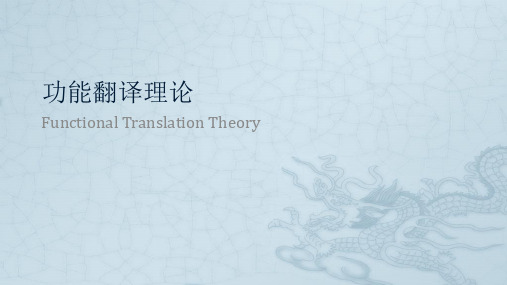
总结Conclusion
功能翻译理论是帮助译者摆脱原语文本形式束缚的一场革 命,它摆脱以文本为中心等值论的束缚,有利于译者能动 地发挥。
Functional translation theory is a reform that helps translators get rid of soure-text forms and equivalent theory based on soure text, good for translators to creat freely.
翻译过程的参与者及其角色分析Participants of translation progress
翻译不但是一种目的性的行为活动,也是一种社会性的行 为。各方面的相互联系、相互影响,构成一个互动的系统。 一般翻译理论认为翻译涉及三方面的参与者:原文作者、 译者、译文接受者。
Translatio is not only a behaviour activity with purpose but also a social activity.All aspects,connecting and influencing each other,make a mutualiginal writer,translator and receiver.
发展Four Stages
它的形成大体经历了四个阶段,其颇具里程碑意义的理论是赖 斯的功能主义翻译批评理论,费米尔的目的论及其延伸理论, 曼塔利的翻译行为理论和诺德的功能加忠诚理论。 functional category of translation criticism Skopos theories and beyond theory of translation action function plus loyalty
功能翻译理论
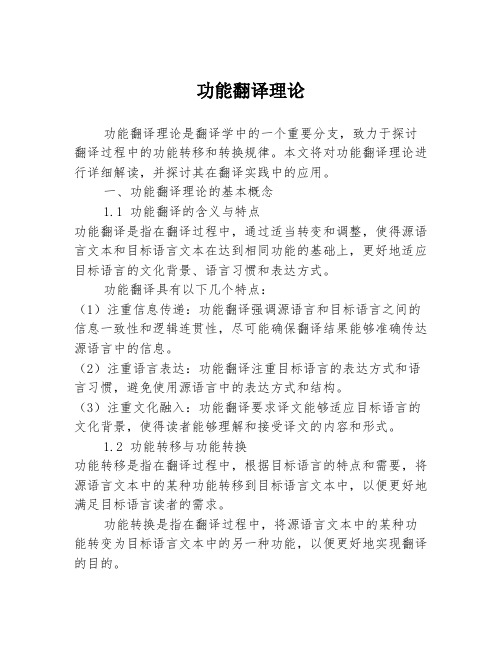
功能翻译理论功能翻译理论是翻译学中的一个重要分支,致力于探讨翻译过程中的功能转移和转换规律。
本文将对功能翻译理论进行详细解读,并探讨其在翻译实践中的应用。
一、功能翻译理论的基本概念1.1 功能翻译的含义与特点功能翻译是指在翻译过程中,通过适当转变和调整,使得源语言文本和目标语言文本在达到相同功能的基础上,更好地适应目标语言的文化背景、语言习惯和表达方式。
功能翻译具有以下几个特点:(1)注重信息传递:功能翻译强调源语言和目标语言之间的信息一致性和逻辑连贯性,尽可能确保翻译结果能够准确传达源语言中的信息。
(2)注重语言表达:功能翻译注重目标语言的表达方式和语言习惯,避免使用源语言中的表达方式和结构。
(3)注重文化融入:功能翻译要求译文能够适应目标语言的文化背景,使得读者能够理解和接受译文的内容和形式。
1.2 功能转移与功能转换功能转移是指在翻译过程中,根据目标语言的特点和需要,将源语言文本中的某种功能转移到目标语言文本中,以便更好地满足目标语言读者的需求。
功能转换是指在翻译过程中,将源语言文本中的某种功能转变为目标语言文本中的另一种功能,以便更好地实现翻译的目的。
二、功能翻译理论的主要流派2.1 功能对等理论功能对等理论强调翻译过程中的功能等值转移,即在翻译过程中,要求译文能够承担与源语言文本相同的功能。
该理论认为,在不同语言文化背景下,信息传递的方式和表达方式可能有所不同,但功能是共通的,应该追求等值转移。
2.2 功能转移理论功能转移理论认为在翻译过程中,需要进行功能的转移和调整,以适应目标语言的需要。
该理论强调在翻译过程中,应该注重翻译结果的实用性和可读性,以满足读者的需求。
2.3 功能转换理论功能转换理论认为在翻译过程中,可以对源语言文本中的功能进行转换,以达到更好的翻译效果。
该理论强调翻译的灵活性和创造性,提倡在翻译过程中发挥译者的主观能动性。
三、功能翻译理论在翻译实践中的应用功能翻译理论在翻译实践中具有重要的指导作用。
功能翻译理论

德国功能翻译理论是20世纪70年代兴起的以赖斯、弗米尔、曼塔利为代表人物的翻译流派。
赖斯的文本类型理论、弗米尔的目的论、曼塔利的翻译行为理论。
赖斯首先于1971将文本功能列为翻译批评的一个标准, 即从原文、译文两者功能之间的关系来评价译文。
当时, 雷斯的理论建立在对等理论基础之上。
因此, 这种关系实际上指的是原文与译文的功能对等。
其中,弗米尔所提出的目的论,是功能派翻译理论中最重要的理论。
所有翻译遵循的首要原则就是目的性原则。
除了目的性原则之外, 目的论还有两个原则: 连贯性原则和忠实性原则。
目的性原则指翻译行为取决于翻译目的,即结果决定方法。
这是翻译中最重要的原则。
连贯性原则指译文对译文读者来说是有意义的。
译文读者理应能够理解译文意思,译文在异域文化中能够与译语读者产生共鸣。
忠实性原则指译文与原文之间二者的关系,译文在语义或必要时在形式上与原文保持一致。
曼塔利进一步发展了功能翻译理论,提出了“翻译行为论”,着重论述了翻译过程的行为、参与者的角色和翻译过程发生的环境条件三个方面的问题。
功能翻译理论既继承了传统译论中的合理成分,又突破了传统译论的束缚。
它认为翻译是在人为目的性参与下进行的,从而将目光转向了对翻译活动中其它相关因素的研究,拓宽了翻译研究的视野,形成了多元化、多角度的翻译研究局面。
功能翻译理论

2.费米尔的目的论及其延伸理论 目的论是功能翻译理论中最重要的理论, 是在语言学派翻译理论之后产生的。它的 提出有重要的背景,即单纯依靠语言学的 理论已无法解释全部的翻译活动和翻译现 象。
Vermeer 认为,行动皆有目的,行动者参照实际环境 选择一种他认为最合适的方式以求达到预期目标; 既然翻译也是一种行动 ,所以译者也会在翻译目的 的指引下 ,尽量考虑一切可能有关的因素 ,从而决 定最合适的行动方式;基于这种对实际情况的描述 ,可以得出一条规范性的基本规则:“翻译行动的目 的决定达到预期目标的策略”,也就是说 ,译文应对 预定的受话者发挥预期的功能.这个观点对传统的 原文中心论是一个颠覆。
特点和习惯 ,对文本
体裁或变体进行划分
信息型 (informative),可分为工具书 、讲
稿 、讽刺作品或者广
文 本
表达型 (expressive) 告等 。
使役型 (operative)
Functional Theories of Translation
功能派翻译理论的形成
当代翻译界翻译理论蓬勃发展,各种理论争奇斗艳。20世纪70年代, 随着经 济的发展和社会的进步,人类的交流也日渐频繁。在这样的背景下,翻译界出 现了面向译语文化的翻译研究趋向,打破了以前文本中心论的翻译研究传统 ,使读者更多地关注译文和译文读者,译文的社会效应和交际功能。
翻译vs翻译行为
曼塔利认为“翻译 (translation )”是一 个狭义的概念 ,它只涉及源语文本的使用 。而“翻译行为 (translational action )” 则是个广义的概念 ,它涉及译者为翻译所 做的一切 ,包括在翻译过程中对文化或技 巧上的考虑 。
Functional Theories of Translation
- 1、下载文档前请自行甄别文档内容的完整性,平台不提供额外的编辑、内容补充、找答案等附加服务。
- 2、"仅部分预览"的文档,不可在线预览部分如存在完整性等问题,可反馈申请退款(可完整预览的文档不适用该条件!)。
- 3、如文档侵犯您的权益,请联系客服反馈,我们会尽快为您处理(人工客服工作时间:9:00-18:30)。
功能翻译理论(functional translation theory)简述功能翻译理论(functional translation theory)诞生在20世纪70年代的德国,形成这一理论有三个杰出贡献者:Katharine Reiss, Hans J. Vermeer and Christiane Nord。
根据杂志上发表的论文、学术会议上宣读的论文、学术报告和出版的专著,功能翻译理论(functional translation theory)的要点简述如下:1、分析概念段(conceptual paragraph,具有明确主题意义一个或多个自然段)和句子的修辞功能,使修辞功能的形式重现,从形式的等同中求得功能的等值,意义的等值,这种翻译叫做功能翻译。
翻译应该是在修辞功能等值的前提下,遵守“信、达、X”规范;文体不同,翻译的目的不一样,X不一样。
(张梅岗,《中国科技翻译》,1994,(3);刘重德,《三湘译论》,湖南出版社,1995;周笃宝,《中国翻译》,2000,(2))2、功能翻译理论(functional translation theory)强调修辞形式等同和功能等值的一致性,修辞是手段,是形式;功能是修辞产生的结果或达到的目的,是内容的总和。
修辞包括概念段内和句内的修辞,即语言语境的修辞,也包括情景语境、文化语境、语用语境的修辞。
(《科技英语修辞》,1998)换句话说,在概念段和句子中,语义、语法和语用三者合为一体表达修辞功能。
3、功能是靠结构(structures)来体现的,任何一种语言都是由四种符号元素(词、词标识、词序和语调)构成。
语言结构(constructions)的认知图式与其他认知领域的认知图式类似,由简单到复杂,由具体到抽象,构成语言因果网络。
概念段贯穿了一条主题链,或称因果键。
这条因果键是命题或语言事件构成的,也是它们的概念化的参考点。
(《中国翻译》,1998,(5)此文已被美国Colby Information Center of Science & Culture收录,网上转载。
)4、功能翻译理论(functional translation theory)强调认知图式理论对翻译实践和翻译研究的作用,各种普遍结构和特殊结构的认知图式越具体、越丰富,对翻译研究和实践的能力就越强,是译者形成图式文本的基础。
5、功能翻译理论(functional translation theory)强调,翻译过程是个斡旋推理过程,因果链是逻辑推理的基本结构,利用已知信息,对非语言要素(如情景、文化和语用等语境)的修辞功能进行判断,产生正确的推时结论。
(《英汉功能翻译》,1999)中国传统翻译理论研究局限于翻译原则或者翻译技巧的研究,缺乏真正的理论研究,自然也就缺乏方法论,所以中国的传统翻译理论很难指导翻译实践。
本文简略介绍功能翻译理论(functional translation theory),并探究其理论基础,通过关联理论详述功能翻译理论(functional translation theory),从而丰富了功能翻译理论(functional translation theory)的内容。
The functionalist translation theory came into being in 1970s in Germany, and there have been three distinguished contributors to the formation of this theory: Katharine Reiss, Hans J. Vermeer and Christiane Nord.In 1971, in her book Possibilities and Limits of Translation Criticism, Katharina Reiss put forward a model of translation criticism based on the functional relationship between source and target texts. However, her theory was firmly within equivalence principle. Yet Reiss is aware that there do exist situations “where equivalence is not possible and in some cases, not even desired” and there are “certain exceptions from the equivalence requirement”(Nord 2001: 9). One exception is when the target text has a different communicative function from the source text. “In such situations, she thinks that the functional perspective takes precedence over the normal standards of equivalence. Then translation critic can no longer rely on features derived from source-text analysis but has to judge whether the target is functional in terms of the translation context.”(Nord 1997: 9)Hans J. Vermeer, the student of Reiss, gave up the source-text centered linguistic translation theory altogether. Based on action theory, Vermeer defined translation as a purposeful human activity that takes place in a given situation. And he made a breakthrough by putting forward his famous Skopostheorie which is regarded as the landmark of functional translation. Skopos is a Greek word for “purpose”, and Skopostheorie means the theory of purposeful action. Skopostheorie includes three principal rules: namely, the Skopos rule, the coherence rule (intratextualcoherence) and fidelity rule (intertextual coherence). Vermeer explains the Skopos rule in this way:Each text is produced for a given purpose which the text is intended to serve. The Skopos rule thus reads as follows: translate/ interpret/ speak/ write in a way that enables your text/ translation to function in the situation in which it is used and with the people who want to use it and precisely in the way they want it to function. (Vermeer 1989a: 20, cit. Nord, 1997)Coherence rule specified that a translation should be acceptable in the sense that it is coherent with the receiver’s situati on, that is, the target-text receivers should be able to understand the target text and interpret it as being sufficiently coherent with their own communicative situation and culture. At the same time, we have to note that since the target text is produced according to the formation offered in the source text, it is expected to bear some kind of relationship with the source text. This relationship is what we call “intertextual coherence” or“ fidelity”.On the basis of Skopostheorie by Hans J. Vermeer, Nord summarized other academic thought and Criticism to the functionalist translation theory. She put forward the loyalty rule, which is the supplement toSkopostheorie. The loyalty rule repaired the disadvantages and limitation of the skopos rule, eliminate the translation at random and avoid the tendency which thinks translation is just target text writing.另外附上一篇关于功能翻译理论起源的文章希望对大家研究功能翻译理论有所帮助。
